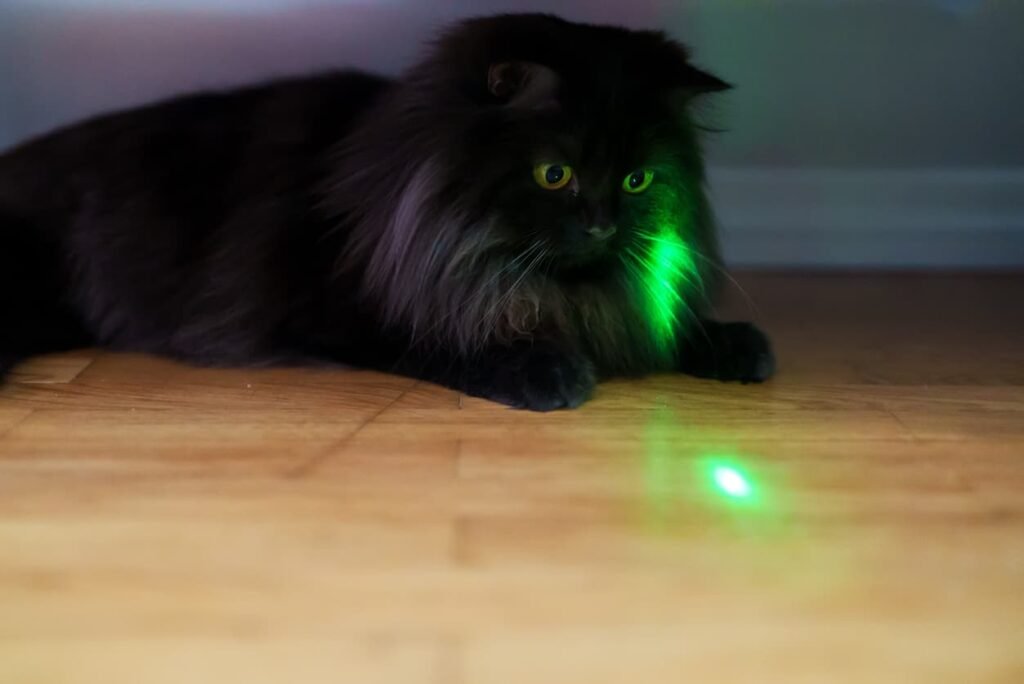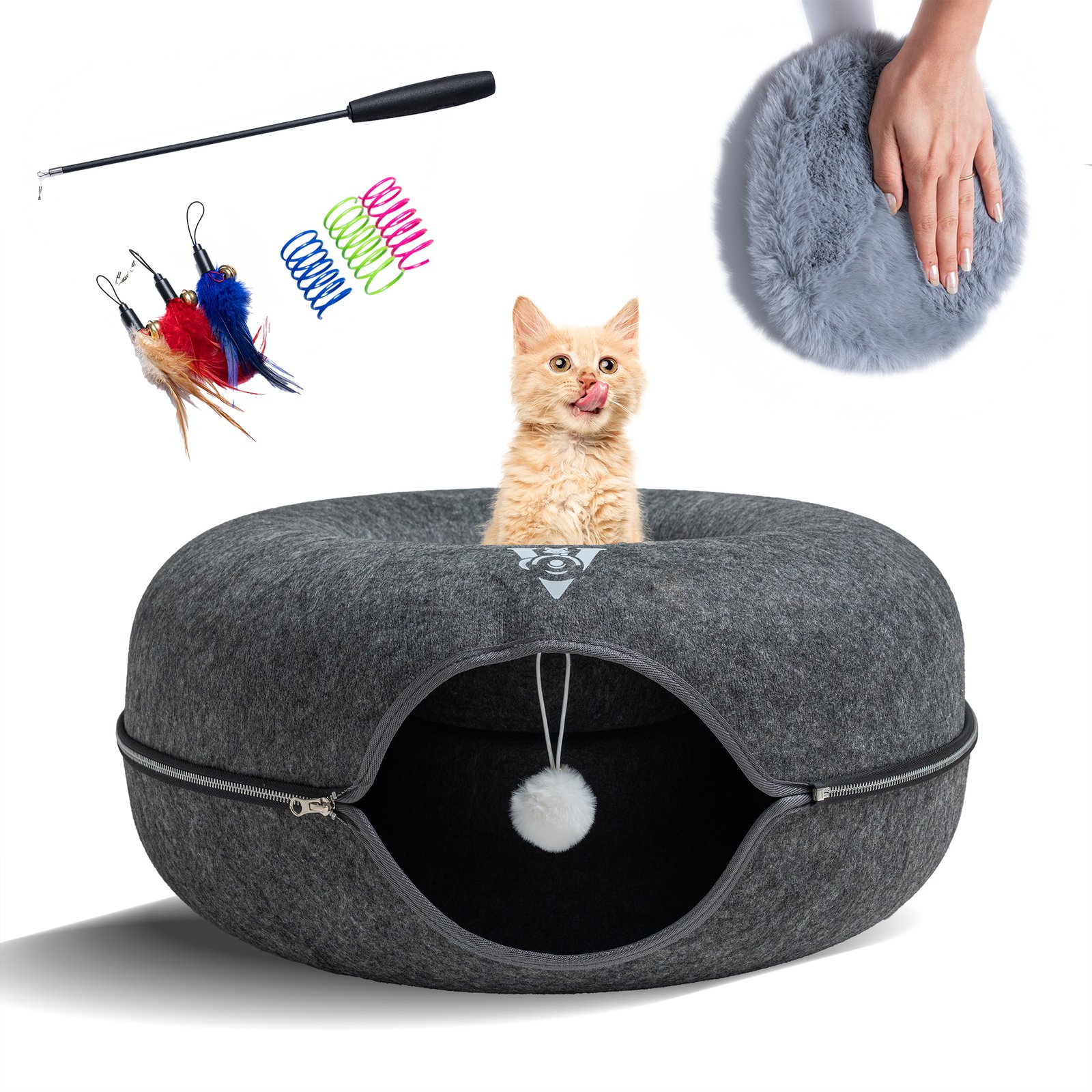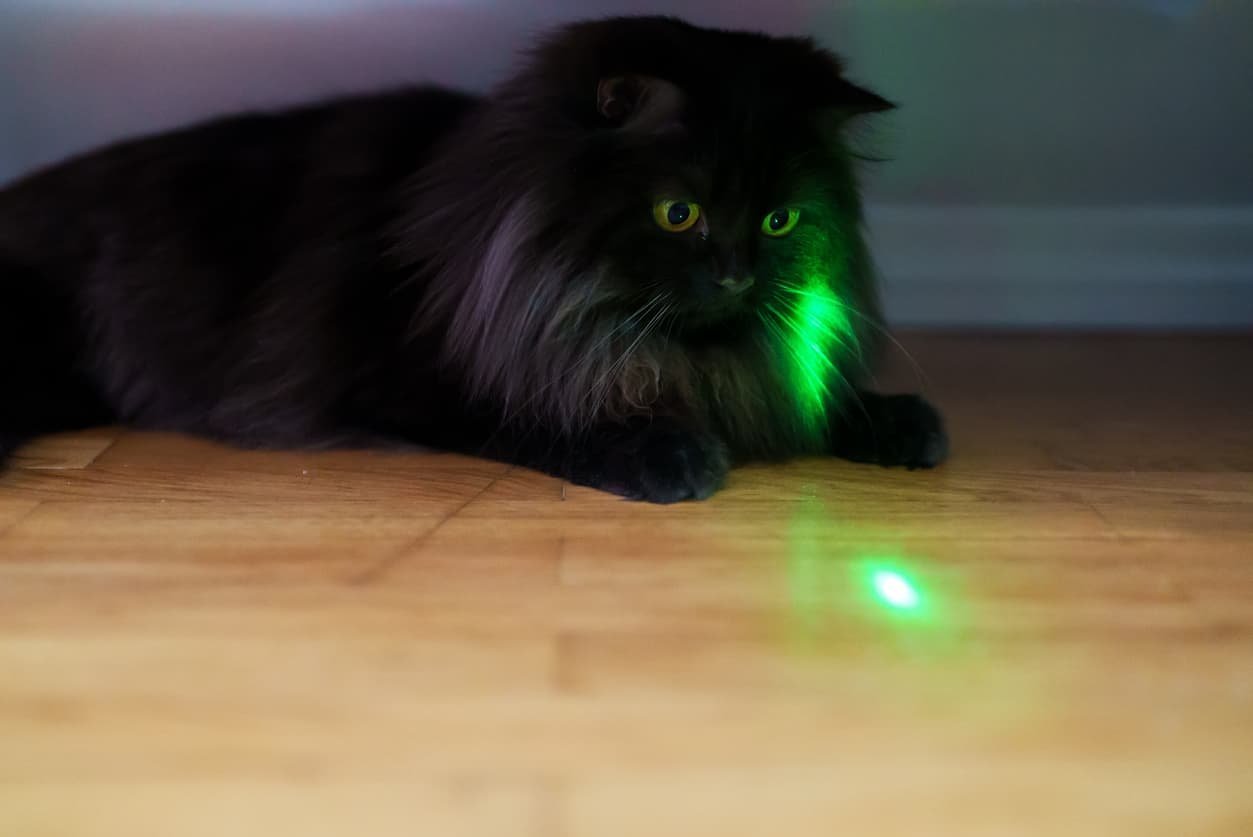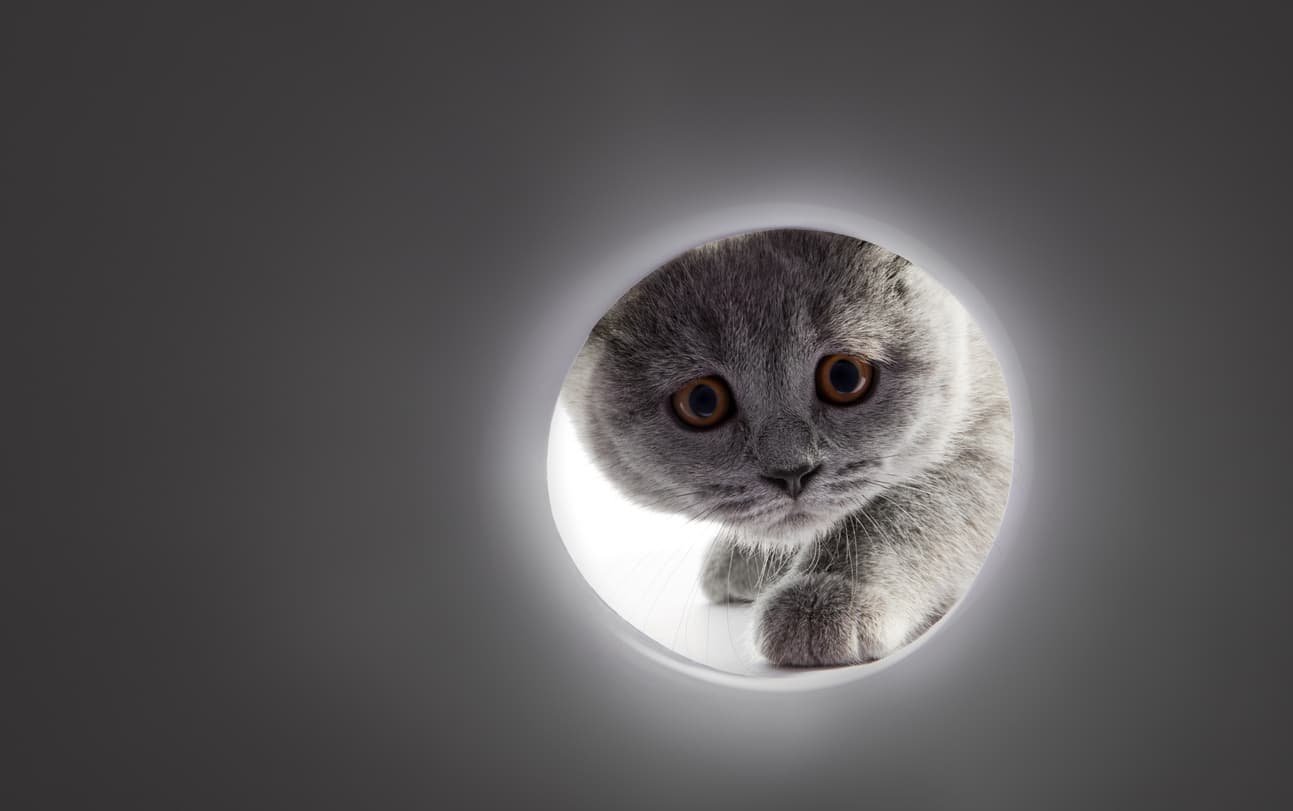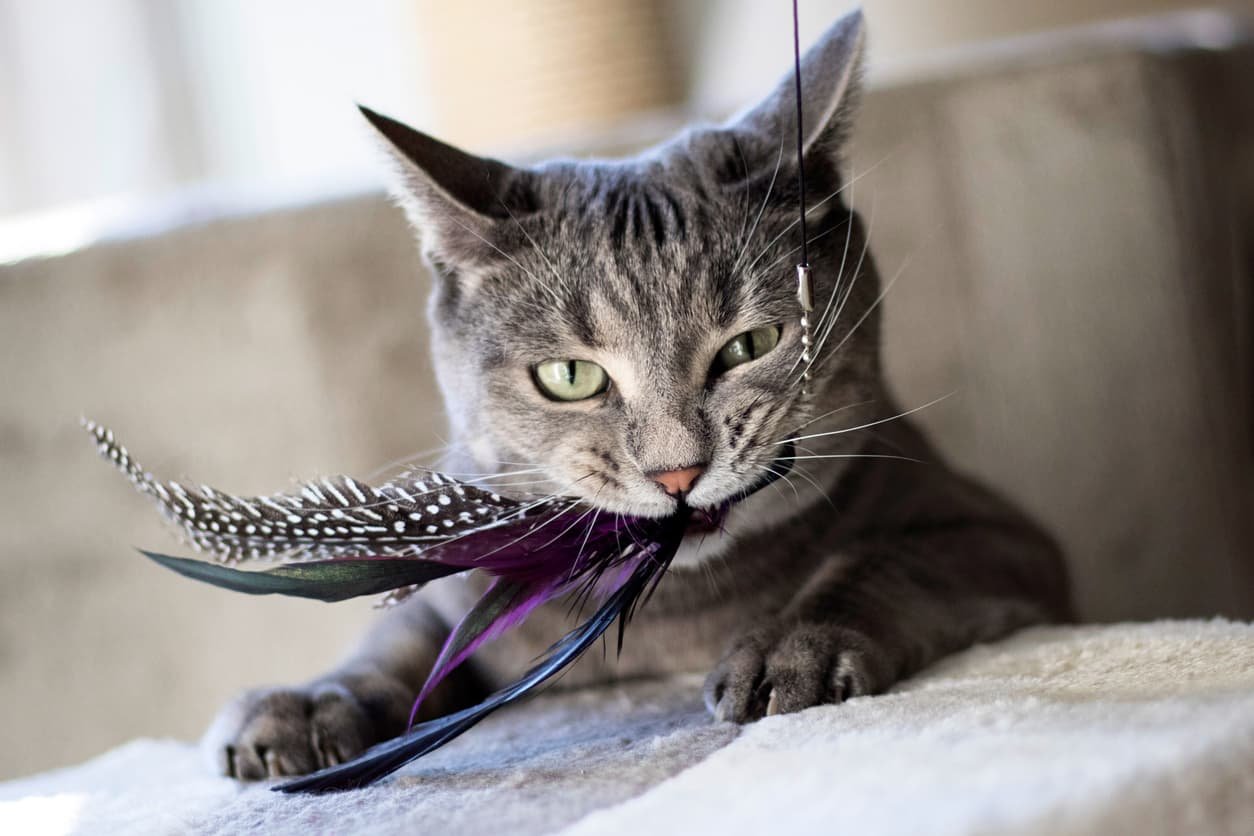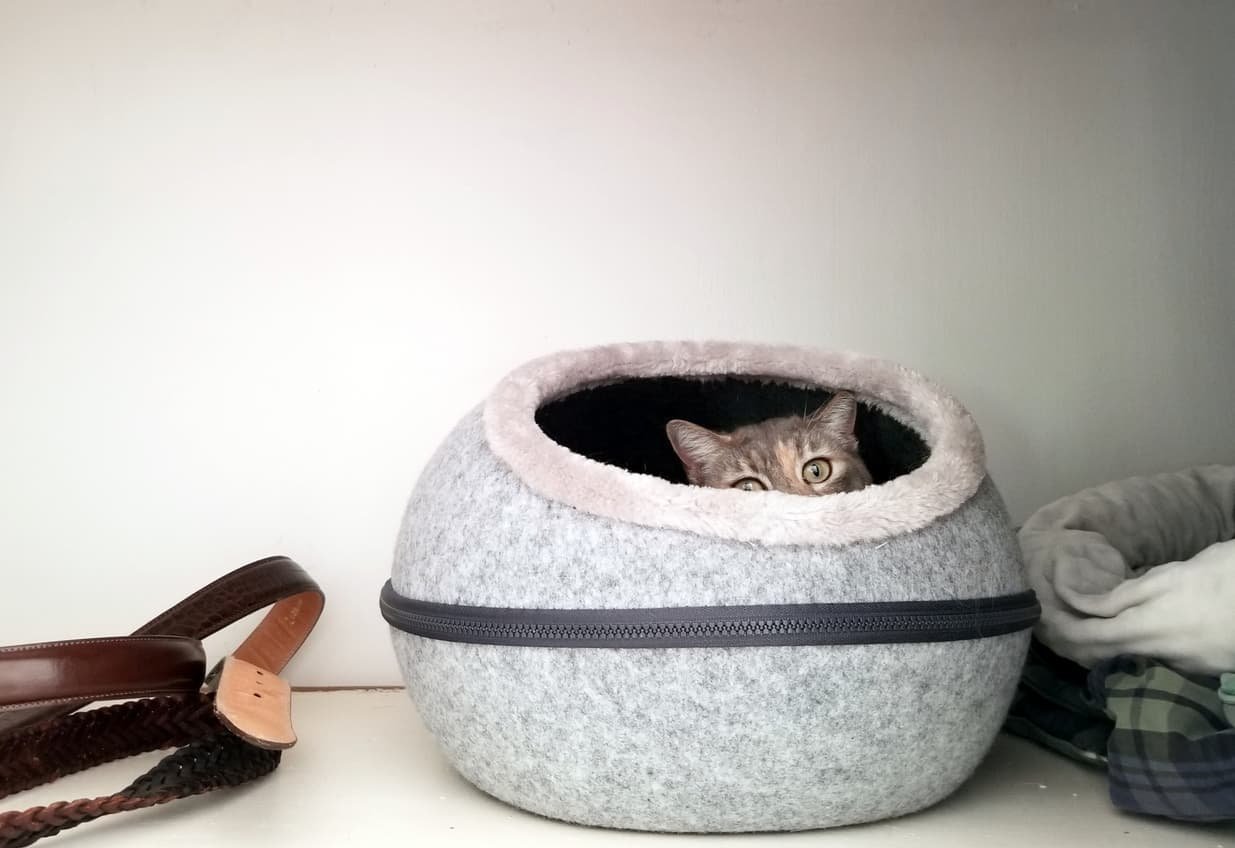Table of Contents
ToggleIntroduction to Cat Laser Toys
Why Are Laser Toys Popular Among Cat Owners
Laser toys are among the most sought-after gadgets in the world of feline play, especially for indoor cats. These toys shine a focused red light that creates a moving dot cats love to chase. The elusive red dot mimics how small prey moves, triggering your cat’s natural instinct to stalk, pounce, and chase.
Cats evolved as natural predators. They rely on quick reflexes, stealth, and curiosity to catch their prey in the wild. Laser play activates your cat’s hunting instinct and gives them a fun way to move more and stay mentally sharp. Pet parents often use laser light toys as a good idea to encourage movement in otherwise sedentary cats.
The laser dot moves randomly across the floor and walls, forcing your cat to stay alert and active. This kind of play supports both heart health and mental sharpness. It also helps busy cat owners keep their pets entertained in a simple, time-saving way.
Another reason cats like laser pointers is the way the light moves. The beam changes direction quickly, stops, and then speeds up again. This kind of motion looks a lot like how prey behaves, which gets cats even more excited to chase it. Cats like laser pointers because the light mimics prey and keeps their attention locked in.
While these toys are widely popular, it’s important to ask the critical question: can cat toy lasers damage eyes? We’ll explore that in detail, but the short answer is yes, if not used properly. That’s why safety tips for laser play, moderation, and awareness are essential for every pet parent.
Types of Laser Toys for Cats
Laser toys come in several different formats. The most common is the handheld laser pointer, which allows the owner to direct the light beam manually. This gives full control over speed, direction, and how long it runs. Handheld laser pointers are usually compact, affordable, and simple to use.
Another option is the automatic laser toy. These toys have built-in motors and an optical scanning system that moves the laser dot across surfaces in a random way. They work well for solo play sessions when the owner is busy. However, owners must actively supervise these sessions to make sure the cat safely avoids direct eye exposure.
There are also hybrid toys that mix laser beams with physical parts like feathers, toy mice, or treat dispensers. These give your cat something to grab, helping prevent frustration from chasing a dot they can never catch.
Whether you’re using a basic laser light toy or a more advanced model, always watch your cat during play. If used for a long time or without supervision, even the most popular toy can become dangerous.
Choose toys with clear safety labels and read expert reviews. Sources like Q&A communities and the Wikipedia article on laser safety offer helpful insights. The online community has discussed laser pointers for cats in depth, including concerns like whether laser pointers are bad for cats and the best safety practices.
Most importantly, end each session by letting your cat catch their prey with a physical toy or treat. This supports healthy hunting behavior and reduces stress from unfinished play.
Can Laser Toys Really Harm a Cat’s Eyes?
Scientific Studies on Laser Exposure in Pets
Researchers and animal doctors have conducted various studies to answer the question: can cat toy lasers damage eyes? The results show that while laser toys can be fun, they also bring risks—especially if people use them the wrong way.
Studies show that the retina—the part at the back of a cat’s eye that senses light—can suffer harm from lasers. A strong or direct laser beam can hurt it quickly. Even a short flash from a Class IIIA laser, often found in pet toys, can cause eye problems. It may lead to irritation, eye damage, or in some cases, permanent vision loss.
In one case, a cat played with an automatic laser toy for too long. Soon after, the cat started blinking a lot and seemed confused while moving around. The toy didn’t have a proper warning label and gave off a stronger light than expected. After an exam, the vet found visible damage to parts of the cat’s eye, including the retina.
Reports shared in Q&A communities and science forums remind pet owners to learn about safe laser types. People should only use toys made for short, safe play sessions. The U.S. Food and Drug Administration (U.S. Food) warns that laser toys with high power or weak safety features may harm both cats and humans. They can harm a cat’s eyes and also human eyes, especially in young children.
Cats don’t always blink fast enough or look away when a bright light shines in their eyes. Cats often chase and stare at moving lights, which puts them at greater risk of eye injury. Even a short moment of repeated direct exposure can cause damage over time.
To keep your cat safe, experts say you should limit laser play time. Never point the laser near your cat’s face. Always finish a session with a real toy or treat, so your cat feels like it caught its prey. These habits lower the risk of injury and let your cat enjoy safe laser fun. There are significant differences between a human retina and a cat’s retina, which is why laser pointers require careful handling.
Signs of Eye Damage in Cats
Knowing how to spot signs of vision issues in your feline friend can prevent serious harm. Cats may not show pain clearly, but there are subtle changes to watch for. If your cat stares at walls, squints often, or hesitates during play, it could signal a problem. These symptoms may appear after using cat laser pointers, especially if used for an extended period or without breaks.
One of the first signs of trouble is a change in behavior. A cat that once enjoyed laser light play may become cautious, confused, or disinterested. These changes can be early indicators of potential damage to the cat’s retina. Owners who ask, “Do cats like lasers?” should also learn how to spot when laser play goes too far.
If a laser pointer toy shines on reflective surfaces, it can bounce light back into the eyes. This can increase exposure to sensitive parts of the eye. In severe cases, this extra exposure may lead to permanent eye damage.
Cats with laser-related issues often repeat strange actions. They might stare at blank walls or chase invisible shapes, even when no light is visible. These are signs of stress or possible compulsive behavior, such as obsessive-compulsive disorder.
Your cat might also show physical warning signs. Red or cloudy eyes, frequent blinking, or watery discharge are clues that something’s wrong. In more serious cases, a cat may seem off-balance, avoid exercise, or have trouble finding its way around. These behaviors may point to vision problems caused by too much laser exposure.
The risk grows when laser products don’t include an appropriate warning label or when the laser pointer’s light is too strong. Devices with high output power and no safety features often bring the most potential dangers.
Automatic laser toys also carry extra risks. Their beam can move in random directions and stay on one spot too long. When your cat keeps staring at the light without moving, the same spot on the eye takes in too much exposure. Even short play sessions with intense lasers can damage individual cells and cause lasting harm. Understanding these risks and significant associations helps pet parents take better precautions.
The good news is that you can avoid most of these problems. Cat owners should use laser products made for pets and follow tips from trusted sources, such as Q&A communities and Stack Exchange Network. Always stay with your cat during laser play and keep each session short.
Wrap up play with a real toy or treat. This step isn’t just routine—it helps your cat complete the natural hunt-eat-groom-sleep cycle. It also keeps their mental health balanced and reduces frustration.
Laser toys are a popular part of the world of cat toy options. They’re an easy way to spark the thrill of the chase. Still, using laser pointers responsibly is key. Play with care, stay informed, and you’ll protect your cat’s eyesight while keeping the fun going.
Safer Alternatives to Laser Toys
Interactive Feather Wands and Puzzle Toys
To play with your cat in a safer and more enjoyable way, try using feather wands or puzzle toys. These toys let your cat touch, bite, and chase something real—unlike laser toys, which cats can’t actually catch.
Feather wands are a fantastic way to mimic real hunting. You control the motion, letting the feather swoop, flutter, or dart across the floor.
This play gives your cat great physical exercise and also supports their mental stimulation. At the end of play, your cat feels satisfied by catching something real. This helps reduce frustration, obsessive-compulsive disorder, and abnormal repetitive behaviors.
Puzzle toys are another smart option. Puzzle toys include treat mazes, food balls, or games that let your cat earn a reward by solving easy tasks. They keep your cat busy and engaged, especially when you’re not home to play. Puzzle toys also offer a safe way to provide entertainment without any of the risks that come with the use of laser pointers for cats.
You can also turn your home into a playground with add-ons like a cat tunnel bed. This multi-purpose item gives your cat a cozy place to nap and a fun tunnel to run through during play. Combining a tunnel with a wand toy creates a complete interactive experience that supports both exercise and comfort.
These alternatives are more than just safe—they give your feline friend a healthy outlet for energy and curiosity. By switching from laser toys to hands-on play, you create a more natural and rewarding experience for your cat.
What To Do If You Suspect Eye Damage in Your Cat
Immediate First Aid Steps
If you think your cat may have suffered eye damage from a laser pointer toy, quick action can help. First, stop the use of the laser pointer immediately. Limit all laser play and switch to wand toys for safe, hands-on interaction.
Check the affected areas around your cat’s eyes. Look for signs like squinting, blinking, or pawing at the face. Too much light in a sensitive area of the eye can irritate it, making your cat’s eye look red, cloudy, or watery. If you’re wondering, “can a pointer harm my kitty’s eyes?”—the answer is yes, especially without safety precautions.
Keep your cat in a dimly lit room to reduce eye strain, and avoid any further exposure time to red lasers or green light. Laser products with high power density can harm both animal eyes and the human retina. Don’t aim lasers near mirrors or shiny surfaces. The light can bounce in opposite directions and make the problem worse.
Avoid using tools like flashlights or magnifiers when checking your cat’s eyes—they can make the discomfort worse. Instead, comfort your feline friend with soft bedding and quiet surroundings until a professional can assess the situation.
When to Visit a Veterinarian
Call your animal doctor if symptoms persist for more than a few hours or if they get worse. Lasers without a safety label or high power can cause lasting eye damage if your cat plays with them for a long time. People often talk about these risks in forums and online community spaces like Stack Overflow and Q&A communities.
Since cat eyes and human eyes are very different, only an animal doctor with the right optical instruments can tell how serious the injury is. If your cat plays with lasers too often, it could start showing odd behaviors or signs of stress, like chasing the elusive red dot even when it’s not there. These signs may point to the idea that laser pointers are bad for cats.
The animal doctor might use tools to check the area of the eye for signs of inflammation or scarring. They will also ask about your cat’s play routines, including the duration of play sessions and the type of laser product used. Mention whether your cat is an outdoor cat, as exposure to natural light can impact healing.
The U.S. Food and Drug Administration (U.S. Food) in the United States advises cat owners to avoid using laser products that aren’t made for pets during interactive play. Following this guidance and switching to safe options like wand toys is a great way to prevent future issues.
At the end of the play session, always let your cat win by catching a real object. This helps avoid the development of compulsive behaviors and supports your cat’s mental and physical health. It’s also a good time to monitor their behavior for signs of vision problems or discomfort.
Prompt attention and a few changes in your play routine can help prevent permanent damage and keep your cat healthy, safe, and happy.
Laser pointers for cats remain a popular toy, but knowing the safety tips for laser use is essential. Do cats like lasers? Yes, most cats like laser pointers because they move in opposite directions quickly and mimic prey. However, the significant differences in eye structure between cats and humans, combined with the risks of optical scanning system features in modern laser toys, mean pet owners must be extra careful. If you ever ask, “Can a pointer harm my kitty’s eyes?” the answer is yes—especially with improper use.
Understanding these significant associations and knowing the different ways to use toys safely will help protect your cat’s vision. Don’t let fun turn into harm. Use the right tools and supervision to ensure safe and healthy play every time.
FAQ
How can I safely use a laser toy for my cat?
To safely use a laser toy, avoid shining it in your cat’s eyes and end play sessions with a tangible toy or treat to prevent frustration. Keep sessions short, fun, and always supervised.
How long should I let my cat play with a laser toy?
Limit laser toy play to 10–15 minutes per session. This keeps your cat engaged without overstimulation. Always finish with a real toy or treat so your cat feels satisfied after the “hunt.”
What are the alternatives to laser toys for cats?
Great alternatives to laser toys include wand toys, feather teasers, interactive balls, treat puzzles, motorized toys, and catnip mice. These engage your cat’s hunting instincts while offering physical and mental stimulation.
How can I make laser play more enriching for my cat?
Make laser play more enriching by mimicking real prey—move the light unpredictably, let your cat stalk, chase, and “catch” it. End with a toy or treat to give a sense of reward and prevent frustration.
Do cats prefer green or red lasers?
Cats generally respond better to red lasers, as red light is more visible to them in low light. However, some may also enjoy green lasers, especially in bright environments. Preference can vary by individual cat.
Are laser pointers safe for cats if used correctly?
Yes, laser pointers for cats can be safe if used properly. The key is to avoid direct eye contact, limit playtime to a few minutes, and always end with a toy your cat can physically catch. Using pet-safe lasers that meet safety standards in the United States reduces risk. Responsible laser play prevents harm and supports healthy behavior.

